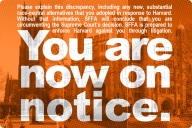You have /5 articles left.
Sign up for a free account or log in.
Claremont McKenna College on Tuesday released a report detailing the extent of the false information it reported on its admissions statistics in recent years. For the college, the good news was that the independent investigation by a law firm found that only one person -- formerly a vice president -- was involved. Further, the college found that the scores of individual applicants were not adjusted, just the aggregate data reported externally (and in some cases internally).
When the college first reported that it had been submitting incorrect information, it referred to modest boosting of SAT scores. But the report found that Claremont McKenna has also been submitting incorrect information about the class rank of its new students (making it look like more of them were in the top 10 percent of their high school classes) and about the percentage of applicants who are admitted (making it seem lower).
In something of a surprise, the report found that the motivation for the incorrect reporting was not (as has been widely assumed) rankings such as those of U.S. News & World Report. Rather, the report said that the vice president disagreed with the president on admissions strategy and opted to follow his strategy on admitting students (admitting more without top SAT scores or class ranks) while fudging the numbers to suggest that he was following the president's strategy. In one possible irony of the scandal, U.S. News editors said last night that, based on a preliminary review of the report, they did not think the inaccuracies would have changed Claremont McKenna's ranking (currently No. 9 among national liberal arts colleges).
Speculation about how colleges report data to those doing rankings (and to the public) has been rampant for years, and there have been instances of law schools submitting incorrect numbers to improve their rankings. And reporters in New Jersey have recently uncovered several instances in which colleges found ways to not report data on some students, so that overall averages would make the colleges look more competitive. But the Claremont McKenna revelations (even just the SAT data reported earlier) have attracted considerable attention among admissions officials because the college is in fact quite highly ranked and respected.
Richard Vos, who had been vice president and dean of admissions, has been identified unofficially as the vice president involved. He has declined comment, but is quoted (identified as "the VP") at length in the investigative report.
How the Vice President Manipulated Data
Class rank is generally reported for rankings and other purposes as the share of freshmen who graduated in the top 10 percent of their high school classes, from those that report class ranks. (Many high schools no longer report class ranks.) While the formula might sound like, well, a formula, the report says that Vos said that calculating top 10 percent was an "art, not a science," and the findings suggest that he believed that he had lots of room to adjust calculations. The report said that his calculations were "unsupportable."
For instance, if a student was ranked below the top 10 percent, but attended an "elite" high school, the student was excluded from calculations -- even if other students from that same high school (those in the top 10 percent) were used in the calculations. The report says that these and "similar means" were used to inflate the top 10 percent ratio.
The impact was significant for the years 2004-11 -- those in which the report found incorrect data reported. During those years, the actual percentage of freshmen with class ranks who were in the top 10 percent of their classes ranged from 65 to 74 percent. The range reported by the college during that period: 83 to 85 percent. In the last year in which false numbers were reported, Claremont McKenna said that 85 percent of its freshmen were in the top 10 percent; in fact, only 71 percent were.
With regard to admissions competitiveness, the report found that the college inflated the number of applicants by counting as an applicant someone who submitted part, but not all, of an application. In 2010 and 2011, these changes were so small that they didn't change the overall admit rate. But in some past years, they did. In 2008, for example, the college reported an admit rate of 19 percent, when it was really 21 percent. In several other years, there was a one-percentage-point difference (always making the college look more competitive).
The real figures contained in the report generally portray Claremont McKenna as an institution with highly competitive admissions, but the massaging of data was to make that competitiveness more intense. In SAT averages, Claremont McKenna reported in 2011 that 55 percent of freshmen had a verbal SAT score of at least 700. The actual figure was 44 percent. For mathematics that year, the figure was reported accurately (62 percent).
The Motive and the Response
The accurate figures for Claremont McKenna are numbers that most admissions directors would consider a triumph. So why did Vos go through the trouble (working alone) of doctoring the figures?
The report says that he did so to try to keep the president (Pamela Gann) happy, not that he was worried about rankings. Vos told investigators that Gann and college leaders wanted to see the SAT averages and other admissions statistics rise, and that Vos feared angering them if he failed to produce classes that would meet that goal. Vos told investigators he tried to make the admissions decisions he believed were correct, and that his massaging of the numbers was designed to keep his bosses happy. The report is not explicit on how this worked, but suggests that Vos admitted more students with slightly lower SAT scores or class ranks than would have advanced the college's statistical goals, giving more recognition to leadership and other non-statistical qualities.
"We believe the VP's assertion to be true," the report says of his motivation. Admissions records suggest that he did continue to admit applicants whom the college's priorities might have called on him to reject. And it appears that the college had enough applicants with high SAT scores that it could have (honestly) continued to raise SAT averages, had Vos been willing to adjust some of his admissions priorities.
While the VP "sincerely feared disappointing" the president, the report concludes that his treatment by the president was professional. The president never threatened his job or salary and was never verbally abusive, nor did she go beyond normal standards in encouraging the VP to meet her goals, the report says. Further, the goals are typical of those at colleges like Claremont McKenna, the college said.
In an interview late Tuesday, Gann stressed that the report had found her goals for admissions to be "totally reasonable" and consistent with the goals of peer institutions. She said that there were not many discussions with Vos on these issues because he gave her statistics -- frequently "misstated" -- that suggested he was following the college's goal in his admissions decisions. While not every goal was met every year, the admissions statistics were not "unreasonably low" when they didn't meet goals, so "it didn't trigger a conversation."
Asked if she was concerned about the idea that some current students might have been rejected by closer adherence by Vos to her guidelines, Gann said that she had no doubts about the quality of the students at the college. "We have a very talented applicant pool and an extraordinarily talented student body," she said. "We have lots of choices, and the students we admit have lots of choices."
She said that she hoped people would realize that the false admissions statistics represented the actions of one individual. "This is not CMC. This was an exceptional incident. Everything we are going to do in response would reflect the true values of the college." And Gann announced various checks Tuesday that would assure that in the future no one individual could falsify data as Vos did.
At least one student at Claremont McKenna, however, raised concerns Tuesday night about whether the college's emphasis on SAT scores and class ranks may have gone too far. Writing on the website of Forum (the student newspaper), the student wrote: "Now that this is put to rest, I ask a set of questions (not [to] justify what Dean Vos did, but to get us thinking about what makes CMC great). I believe that some of CMC's very engaged/impactful students and alumni have got into CMC on other attributes like leadership potential and other experiences, despite less than amazing SAT scores, I love that about CMC (despite being an academic powerhouse, we have brought in a few dynamic bright non-book smarts or academically distracted), and I hope we factor that into admissions decisions."








